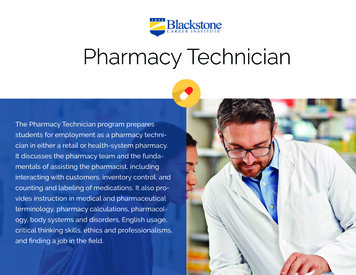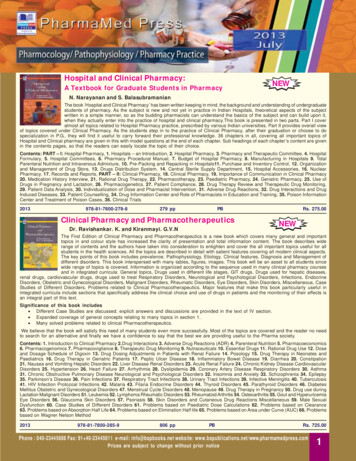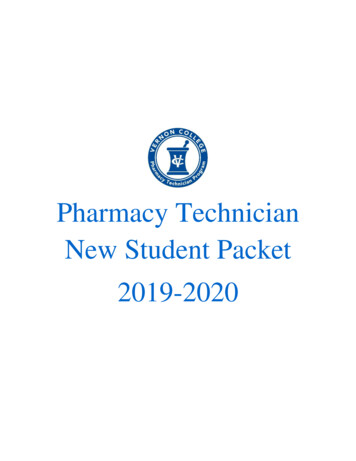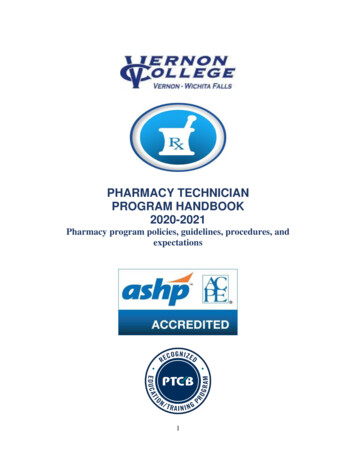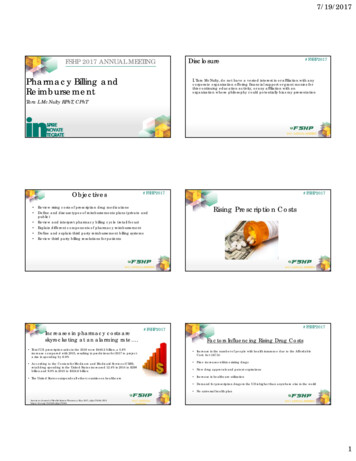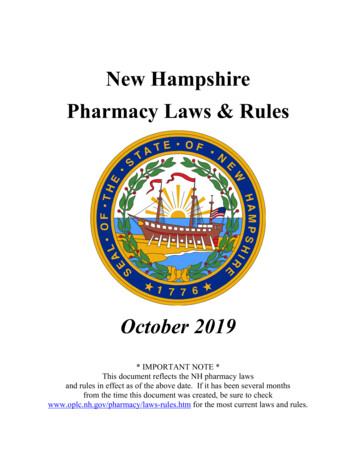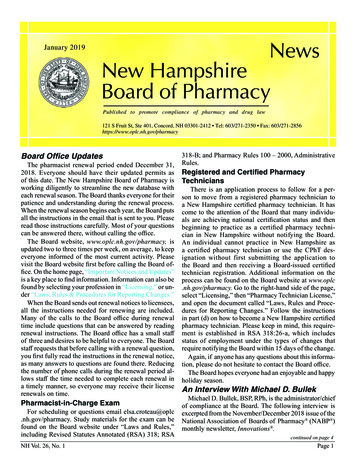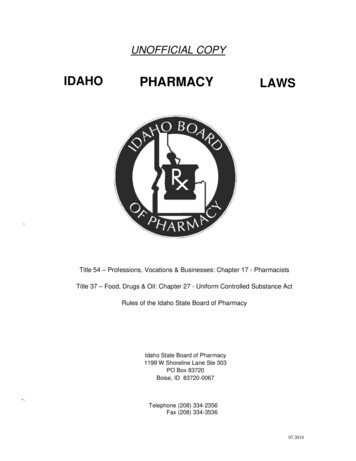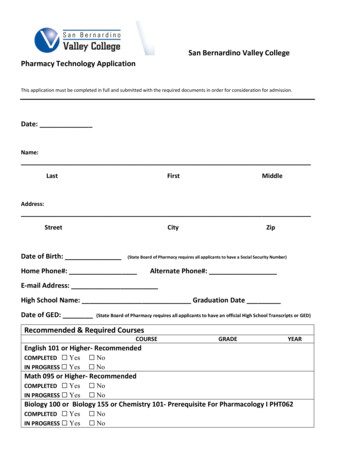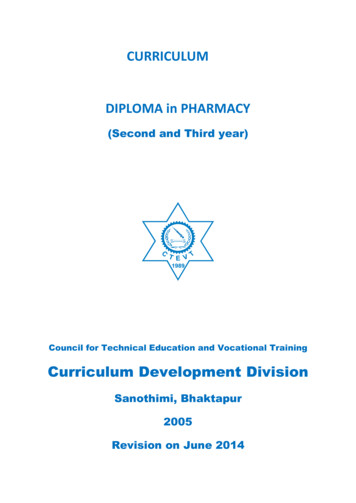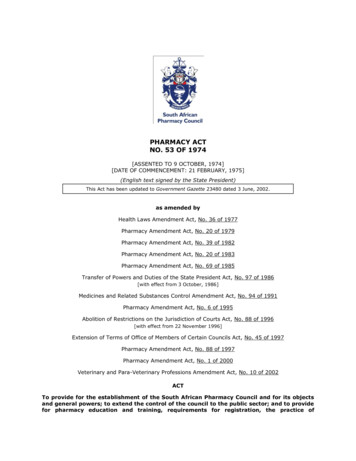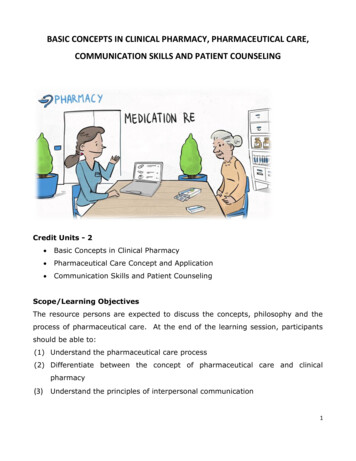
Transcription
BASIC CONCEPTS IN CLINICAL PHARMACY, PHARMACEUTICAL CARE,COMMUNICATION SKILLS AND PATIENT COUNSELINGCredit Units - 2 Basic Concepts in Clinical Pharmacy Pharmaceutical Care Concept and Application Communication Skills and Patient CounselingScope/Learning ObjectivesThe resource persons are expected to discuss the concepts, philosophy and theprocess of pharmaceutical care. At the end of the learning session, participantsshould be able to:(1) Understand the pharmaceutical care process(2) Differentiate between the concept of pharmaceutical care and clinicalpharmacy(3) Understand the principles of interpersonal communication1
BASIC CONCEPTS IN PHARMACEUTICAL CAREOUTLINE: Basic concepts in Clinical Pharmacy and Pharmaceutical Care.1.0Clinical PharmacyThis is the branch of pharmacy where pharmacists provide patient care that optimizes the use ofmedicines, promotes health, wellness, and disease prevention. Clinical pharmacists provide care forpatients in all healthcare settings but the clinical pharmacy movement began in the hospital/ clinicalsetting.Clinical pharmacists are experts in the: Therapeutic use of medicines, Provision of consultancy services like Medication Therapy Evaluations (system wide or for aparticular patient), Medication Use Reviews (specific patients), Drug Utilization Evaluation, Provision of scientifically and clinically valid information and give advice about the safety,appropriateness and cost-effectiveness of medications.Basic components: Prescribing drugs Administration of drugs (immunization, dangerous drugs) Documentation Reviewing of drug use Communication Counseling Consulting Preventing medication errors.Activities: Drug information Drug utilization reviews Drug evaluation and selection2
Medication therapy management Formal education and training programs Disease state management, etc1.1Consultation Who is the patient? What has changed for the patient? Why has the patient come now? How do we tackle the problem?1.1.2 Basic Tasks in a Consultation Discover the reason for patient’s coming: consider who the patent is, establish rapport, knowthe history of the problem, patient’s ideas, concerns and expectations, values and beliefs. Getthe most input from the patient- we understand that patients usually form an idea about whatis happening to them before visiting the healthcare provider. Consider other problems: continuing problems and risk factors. Undertake medication usereviews, tests etc to identify such issues. Choose an appropriate action: reassurance, treatment or referral. Achieve a shared understanding: the patient needs to understand the etiology, treatment andlifestyle modifications recommended. This puts responsibility on the patient. Involve the patient in the management: long term outcomes depend on getting informedconsent and this enables the patient to take responsibility. Discuss the treatment optionsavailable and present evidence in an objective manner but let the patient decide. Then makean accordance plan. Use time and resources appropriately: do not follow up unnecessarily. Establish or maintain a relationship: smile, radiate empathy and appear interested in thepatient. The patient needs to trust you.3
2.0Pharmaceutical CareIt is the responsible provision of drug therapy for the purpose of achieving definite outcomes thatimprove or maintain a patient’s quality of life. It can be distinguished from clinical pharmacy as shownin the table below.Clinical PharmacyPharmaceutical CarePlaceClinical settingEverywhereTargetHealthcare providersPatientGoalClinical Outcomes,Patient Related ontinuousGlobal BenefitsSpecializationFuturistic and holisticThe skills, activities and services inherent in the provision of pharmaceutical care include, but are notlimited to the following: Patient assessment: Clinical skills for physical assessment, eliciting barriers to adherence andidentification of psychosocial issues. Patient education and counseling: Pharmacists must have patient interview skills,communication skills (e.g., empathy, listening, speaking or writing at the patient’s level ofunderstanding), ability to motivate or inspire patients to follow through a recommendedtherapy plan, ability to develop and implement patient education plan based on an initialeducation assessment and the ability to identify and resolve compliance barriers. Patient-Specific Pharmacist Care Plans: Recognition, prevention, and management of druginteractions, interpretation of laboratory tests, have knowledge of community resources,professional referrals, communication and rapport with community medical providers. Drug Treatment protocols: The pharmacist should be able to develop and maintain (update)protocols, follow protocols as a pharmacist clinician and monitor aggregate adherence to4
treatment protocols (e.g., drug utilization evaluations {DUE} ) especially for managed care orhealth system facilities (e.g. hospitals). Dosage adjustment: The pharmacist should be able to identify patients at risk for exaggerated(pediatric or geriatric patients) or sub-therapeutic response, apply pharmacokinetic principlesto determine patient-specific dosing especially for drugs that are considered high risk (e.g.warfarin, digoxin), order and interpret relevant tests at correct time intervals to assess dosageadjustment (e.g., plasma drug concentrations, blood glucose levels, blood pressuremeasurements). Selection of therapeutic alternatives: The pharmacist should be able to use drug informationresources effectively; review and critique drug literature and construct comparative analysesto support therapeutic decisions. Prescriptive authority in designated practice sites or positions: This is not currentlyoperational in Nigeria. It is envisioned that as roles of pharmacists expand and availablereviews point to the cost effectiveness of pharmacist interventions, provider status may beaccorded even in Nigeria. Preventive services: Immunizations, screenings, health and wellness education can be carriedout successfully at a community practice.The pharmacist should also be skilled to plan, direct and implement pharmaceutical care activitieswithin various practice environments, such as community pharmacy, ambulatory care settings,managed or contractual care, home health services, long-term care facilities, inpatient hospitalpractice, and others. Allocating resources in the pharmacy is also a direct responsibility of thepharmacist.2.1Pharmaceutical Care as the Model for Pharmacy PracticeThe concepts, activities and services in pharmaceutical care form the basis for provision of clinicalservices directly to, and for the benefit of patient in all pharmacy practice settings. These settingsinclude home health, hospital, ambulatory care, primary care, consultation, long term care, andcommunity pharmacy practice. Workflow, staffing patterns, processes, and pharmacy programs mightdiffer, but the core approach to patient care remains pharmaceutical care in all settings.5
2.1.2 Documentation of Pharmaceutical CareDocumentation of pharmaceutical care is integral to the continuity of care, demonstration of cliniciancompetence, communication among health care providers, evidence of contributions to patient care,and reimbursement of professional services.1. Pharmaceutical care, including the pharmaceutical care plan process (CORE, PRIME & FARM/SOAP), is a systematic method for recording the pharmacist’s examination of a patientpharmacotherapy and subsequent identification of medication-related problems.2. In most practice settings, computer software programs maintain patient data and drug profilerecords. Thus, after documentation of the initial pharmaceutical care plan, patient data ordrug regimens are included in subsequent FARM notes only if a change occurs that is relevantto the therapeutic issue being addressed in the note.3. Forms that summarize pharmacist’s interventions using a unified coding system are useful forprocessing reimbursement of billing forms, but these forms are not adequate documentationof pharmaceutical care. These forms do not communicate to other health professionals thedepth and quality of pharmacist interventions or the pharmacist’s plan for ongoingpharmaceutical care.2.2Pharmaceutical Care: An ongoing ProcessThe patient profile is revised and re-assessed each time a new drug is added to or deleted from themedication regimen, a new disease or condition is diagnosed, or the patient undergoes other clinicalintervention, such as surgery. When the patient returns to the pharmacy or is readmitted to thehealth system facility, the pharmacist uses the patient profile, PWDT, and FARM notes (maintained inthe patient pharmacy chart or in the medical chart) as the basis for ongoing pharmacists-patientinteractions.2.3Importance of Pharmaceutical Care in Today’s Pharmacy PracticeThe potential for medication errors is growing, and one professional group must assume a primaryrole in addressing this issue rather than fragmented efforts by various groups or individuals. Thepharmacist is trained specifically to address these therapeutic issues. The use of prescription andnonprescription medications is growing and now constitutes the primary therapeutic modalityavailable to health care practitioners and patients. The number, complexity, and efficacy of6
prescription and non-prescription drug products are also increasing. These challenges put thepharmacist in the best position to combat these drug therapy problems.The need for pharmaceutical care secures an enduring role for the pharmacist in the Nigerian healthcare system. Every encounter with patients, regardless of practice setting provides an opportunity forpharmaceutical care. The Pharmaceutical care activities will also integrate pharmacists into the healthcare system of the future.2.4Pharmacist Work-up of Drug Therapy1. Data collection2. Develop or identify the CORE Condition of the patient Outcomes desired in the specific patient Regimen selected Evaluation parameters3. Identify the PRIME pharmacotherapy need Pharmaceutical based problems Risks to the patient Interactions Mismatch between medication and condition or patient needs Efficacy issues4. Formulate a FARM/ SOAP note: Findings- patient specific information Assessment- evaluation of findings e.g. severity, duration Resolution (including prevention) – rationale for the intervention should be mentioned Monitoring (and follow up)- assess efficacy, safety and outcome of the intervention7
COMMUNICATION SKILL AND PATIENT COUNSELING1.0Communication SkillsCommunication (from Latin commūnicāre, meaning "to share" [1]) is the activity of conveyinginformation through the exchange of ideas, feelings, intentions, attitudes, expectations, perceptionsor commands, as by speech, gestures, writings, behaviour and possibly by other means such aselectromagnetic, chemical or physical phenomena. It is the meaningful exchange of informationbetween two or more participants (machines, organisms or their parts).[2][3]The communication process is not complete until the receiver understands the meaning of themessage sent and gives a feedback.1.2Media for CommunicationCommunication is carried out using a broad spectrum of media, the means through which themessage is encoded for transmission to the receiver.The medium used in conveying a message must be appropriate for the purpose it is intended e.g. useof text message to inform client of the death of a loved one will be inappropriate. The medium usedmust also retain the integrity of the message from when it is sent, to when it is received. The mediumused must also be matched to the audience size e.g. in small groups verbal communication with(out)the use of amplifiers will be appropriate, while for large groups, mass media will be deployed.In the Pharmacy, it one-to-one interpersonal communication that is the most commonly used methodand this does not require amplifiers but can be enhanced when tone, voice quality, and other mediaaids like pictograms etc are used.1.3Elements of the Communication ProcessEvery message must be appropriately matched. And requires certain properties to ensure it is notmuddled or lost in translation.The following acronym MSCREF describes the basic elements of the communication process M- Message should be clear, concise and straight to the point. It is important that there are noexaggerations if unintended or if it will distort the message or elicit an adverse reaction in the8
receiver. Tone is very important especially since messages are often interpreted messagesbased on the tonality. S- Sender of the message must be in the appropriate frame of mind to encode the messagearight, and attempt to eliminate obstacles to the appropriate message being sent to theappropriate recipient. C- Channel is same as medium, i.e. the medium through which message reaches the receiver.Channel must be effective and culturally acceptable to the target. The sender must be able touse the medium appropriately i.e. encode the message appropriately for it to be relayed toand decoded by the receiver. R- Receiver is the final recipient. The receiver must be appropriately tooled to decode andinterpret the message i.e. must be able to process the message, leading to understanding andappreciation of the intended message. E- Effect or reactions to the message received by the recipient. Effects may be appropriate,timely and effective. A good message will elicit the appropriate response without any biasleading to the expected action. F- Feedback originates from the recipient of the message. This may include seekingclarification or (if the message is clear enough) verbalizing receipt. Feedback is important inhelping the sender know if the message was received as intended.1.4Types of Communication1.4.1 Intra-Personal Communication This is talking within oneself. It is the thought going on within a person. Takes place before any other form. Before you talk to any type of audience or take any action, you must think about it. It follows therefore, that conflict within oneself can negatively influence communication withothers .9
1.4.4 Interpersonal CommunicationInterpersonal communication is the face-to-face verbal and nonverbal exchange of information, ideasor feelings between individuals or groups.Types of Interpersonal Communication: Verbal Communication: This is the exchange of ideas through spoken or written expression(word). Non-verbal Communication: This involves the expression of ideas, thoughts or feelings withoutthe spoken or written word. This is generally expressed in the form of body language thatincludes gestures and facial expressions. Both verbal and non-verbal form the basis of interpersonal communicationNon-Verbal Communication (NVC)NVC are forms of communication other than verbal messages. The body language and manner inwhich something is said (vocals) are important components.Non-linguistic NVC comprise of four main elements: Body contact Interpersonal space Body movement (sometimes referred to as 'kinetics'), eyes, face, hands and arms, legs andfeet, posture, appearance) . AppearanceLinguistic NVC include vocal pitch, tone, etc1.5Essential Skills for Effective Communication Questioning skills Listening skills Participatory skills Explaining skills10
1.5.1 What is a question?It is a request for information. The purpose is to: Obtain specific information Diagnose specific difficulties Open interactions (e.g. 'Hello, how may I help you?') Assess knowledge and understanding Help create enlightenment Maintain control of interactions Encourage full participation Show interest and concern (e.g. 'How are you today, sir?') Ascertain attitudes, opinions and feelings (e.g. 'How do you feel about.').Types of Questions Open and closed questions Direct and Indirect Questions Loaded and Leading Questions Multiple questionsQuestioning Tips Use a tone that shows interest, concern and friendliness Use words that the client understands Ask one question at a time and wait with interest for the answer Ask questions that encourage clients to express their needs, e.g.” May I ask you about yourschool and family?” Use words such as ‘then’ “oh”. These words encourage clients to continue speaking Avoid starting a question with ‘why’; this suggests that one is finding fault When asking a delicate question, explain why you are asking (e.g. when asking about thenumbers of sexual partners to find out about STI/HIV risk) Ask the same question in other ways if the client has not understood11
1.5.2 What is Listening?It is a fundamental part of communication process. It is not just physiological process of hearing butlistening is a mental process. It is important to listen carefully to respond appropriately.Indicators of Listening Can be verbal or nonverbal Reinforcers Probing Verbal followingObstacles/Barriers to ListeningListening is normally a difficult process and can be made more difficult with obstacles like Speech and Thought Rates Speaker Fluency and Clarity Message Emotion Individual Bias Inattentiveness Mental Set Dichotomous Listening Other DistractionsOn deliberate choice to close interaction or decision to divert focus of conversation, useful tactics toachieve these include: Rejecting involvement Denial of feelings Selective responding Admitting insufficient knowledge Topic shift Referring, Deferring Pre-empting any communication12
Participatory SkillIt is a skill to actively engage or involve the patient in the discussion. It involves encouraging feedbackfrom patient.Explaining SkillsGood explanations are crucial to effective communication. Explanations can be by oral, visual aids,presentations or combinations of these. Oral explanations -no other form of aid is available. Visual aids to illustrate information difficult to convey. Illustrations are the most important elements of instructions. Presentation is the core of explanation Feedback: This is a method for assessing the effectiveness of explanations. It can be obtainedprior to giving explanation.Features of ExplanationLike good bikinis, should be brief, appealing, and cover essential features.Reflecting - a reference to past statements is an effective means of summarization.1.6Factors Affecting Communication Not paying enough attention to message Not clarifying message Partial listening Partial understanding Personal interpretation of message Message – Too long Mood of sender/receiver Tone of language/speech Language barrier Senders/ receivers mannerism13
Differences in pronunciations and accents Culture, beliefs Age Incomplete/distorted information Noise Physical Barrier- An example of this is the natural barrier which exists if staff are located indifferent buildings or on different sites. System design- Examples might include an organizational structure which is unclear andinefficient or inappropriate information systems Attitudinal barriers -as a result of problems with staff in an organization Ambiguity of words/phrases- Words sounding the same but having different meaning Physiological barriers - may result from individual’s personal discomfort, caused, for example,by ill health, poor eyesight or hearing difficulties.1.6.1 Communication NoiseIn any communication model, noise is interference with the decoding of messages sent over a channelby an encoder. Environmental noise- standing next to loud speakers at a party or a rowdy time at thepharmacy. Physiological-impairment noise- deafness or blindness Semantic noise- Different interpretations e.g. weed Syntactical noise-mistake in grammar Organizational noise- unclear and badly stated direction Cultural noise e.g. wishing a non-Christian ‘Merry Christmas’ Psychological noise- great anger or sadness may cause someone to lose focus on the presentmoment14
2.0CounselingCounseling is an interaction between two or more persons whereby information is received from theother on an issue and the information is provided with all possible solutions highlighted and theperson is allowed to make an informed decision.Counseling can also be said to be interpersonal communication in which a counselor (serviceprovider) helps the client to:-identify-clarify-resolve problemsTypes of Counseling Individual Counseling Couple Counseling Group Counseling2.1Principles of CounselingIn Counseling the following must be noted:- What does the individual already know? One should never assume that people do not knowanything- Age should be considered when counseling- Always be patient, try to understand clearly what the person is saying/wants- Use the language the person understands- Never guide or advice to choice making- Be honest and nonjudgmental- Support expressed fears and feelings- Maintain a culturally accepted distance between client and counselor- Ensure confidentiality15
2.2Counseling ProcessThe Processes is best explained with the acronym GATHER which meansGreetAskTellHelpReturn2.2.1 Difficult Moments in CounselingThis can occur if client stops talking (usually due to a concern of confidentiality or judgment), clientcries, or counselor cannot provide answer. Sometimes, the counselor has little time to attend to clientand client talks continuously and inappropriately. If the client is well known to counselor, it may bemore appropriate to refer them to another counselor. If the counselor is embarrassed by the subjectmatter, then refer.2.32.4Qualities of a Good Counselor Approachable Friendly and warm A good listener Tolerant and patient Welcoming and humorous Well focused Self-confident Confidential and willing to go extra milePatient CounselingThis is a patient-focused intervention. It can be non-drug counseling where the patient receiveseducation for positive behavioral changes – health promotion and disease prevention measures.Whereas with drug-focused intervention, the focus is on Medication education for appropriate16
adherence to pharmaceutical care plans by patients or rational prescribing or resolution of a drugtherapy problem.2.4.1 Drug Focused CounselingAfter a session of medication/drug focused counseling, it is important that the patient should havebeen provided a minimum of; The name and purpose of medication How much of the medication that should be taken, when to take it and how long to take it. How to administer medicines. Prescription refill information. What to do when a dose is missed. Important side effects e.g. causes dizziness, stomach irritation, etc. Precautions e.g. causes sleep do not drive; avoid exposure to sunlight when on thismedication. Interaction with foods, beverages and other medicines. How to store medicines at home.Good communication skill and correct patient counseling are very important skills that everypharmacist irrespective of area of practice must develop and grow to achieve measurablepharmacological and non-pharmacological therapeutic output in patients and other clients.References1.Harper, Douglas. "communication". Online Etymology Dictionary.2.Wiener, Norbert (1948). Cybernetics, or Control and Communication in the Animal and theMachine. Cambridge: MIT Press.3.Jump up de Valenzuela, Julia Scherba. (1992). American Speech-Language-Hearing Association(ASHA): Guidelines for Meeting the Communication Needs of Persons With Severe Disabilities4.West African Postgraduate College of Pharmacists (WAPCP) Communication lecture note.17
1.0 Clinical Pharmacy This is the branch of pharmacy where pharmacists provide patient care that optimizes the use of medicines, promotes health, wellness, and disease prevention. Clinical pharmacists provide care for patients in all healthcare settings but the clinical pharmacy movement began in the hospital/ clinical setting.
